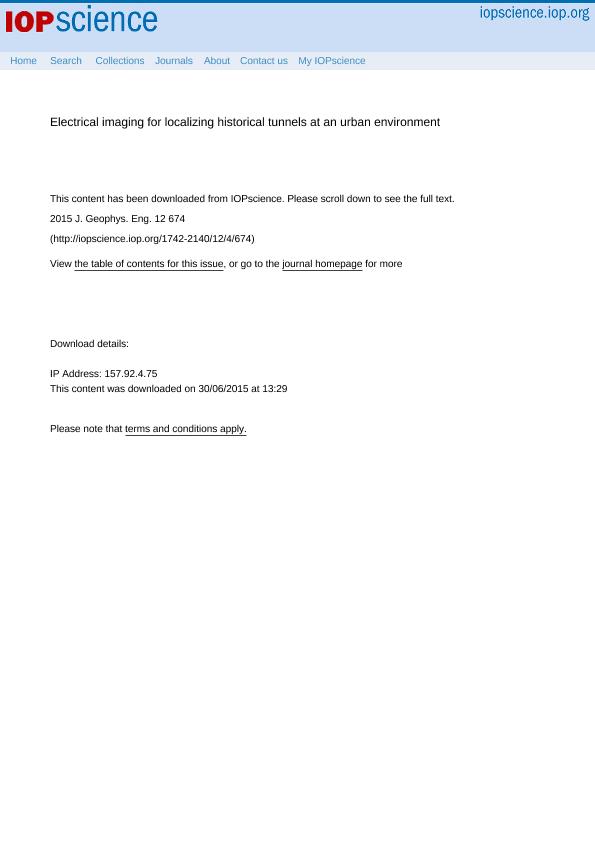Artículo
Electrical imaging for localizing historical tunnels at an urban environment
Osella, Ana; Martinelli, Hilda Patricia ; Grunhut, Vivian; de la Vega, Matias
; Grunhut, Vivian; de la Vega, Matias ; Bonomo, Nestor Eduardo
; Bonomo, Nestor Eduardo ; Weissel, Marcelo Norman
; Weissel, Marcelo Norman
 ; Grunhut, Vivian; de la Vega, Matias
; Grunhut, Vivian; de la Vega, Matias ; Bonomo, Nestor Eduardo
; Bonomo, Nestor Eduardo ; Weissel, Marcelo Norman
; Weissel, Marcelo Norman
Fecha de publicación:
08/2015
Editorial:
IOP Publishing
Revista:
Journal of Geophysics and Engineering
ISSN:
1742-2132
Idioma:
Inglés
Tipo de recurso:
Artículo publicado
Clasificación temática:
Resumen
We performed a geophysical study at a historical site in Buenos Aires, Argentina, corresponding to the location of a Jesuit Mission established during the 17th century, remaining there until the 18th century. The site consisted of a church, cloisters, a school, orchards and a procurator’s office; also several tunnels were built, connecting the mission with different public buildings in the town. In the 19th century the Faculty of Sciences of the University of Buenos Aires was built in a sector of the site originally occupied by an orchard, functioning until its demolition in 1973. At present, this area is a cobbled square. With the aim of preserving and restoring the buried structures, work was carried out in this square looking for tunnels and remains of the basement of the old building. Considering the conductive features of the subsoil, mainly formed by clays and silt, the complex characteristics of the buried structures, and the urban localization of the study area with its consequent high level of environmental electromagnetic noise, we performed prefeasibility studies to determine the usefulness of different geophysical methods. The best results were achieved from the geoelectrical method. Dipole–dipole profiles with electrode spacings of 1.5 and 3m provided enough lateral and vertical resolution and the required penetration depth. Reliable data were obtained as long as the electrodes were buried at least 15 cm among the cobble stones. Nine 2D electrical resistivity tomographies were obtained by using a robust inversion procedure to reduce the effect of possible data outliers in the resulting models. The effect on these models of different error estimations was also analyzed. Then, we built up a pseudo-3D model by laterally interpolating the 2D inversion results. Finally, by correlating the resulting model with the original plans, the remains of the expected main structures embedded in the site were characterized. In addition, an anomaly was identified that indicates the presence of a tunnel not previously reported.
Palabras clave:
GEOFÍSICA
,
TÚNELES HISTÓRICOS
,
BUENOS AIRES
,
ARQUEOLOGÍA Y PATRIMONIO
Archivos asociados
Licencia
Identificadores
Colecciones
Articulos(IFIBA)
Articulos de INST.DE FISICA DE BUENOS AIRES
Articulos de INST.DE FISICA DE BUENOS AIRES
Articulos(SEDE CENTRAL)
Articulos de SEDE CENTRAL
Articulos de SEDE CENTRAL
Citación
Osella, Ana; Martinelli, Hilda Patricia; Grunhut, Vivian; de la Vega, Matias; Bonomo, Nestor Eduardo; et al.; Electrical imaging for localizing historical tunnels at an urban environment; IOP Publishing; Journal of Geophysics and Engineering; 12; 4; 8-2015; 674-685
Compartir
Altmétricas



